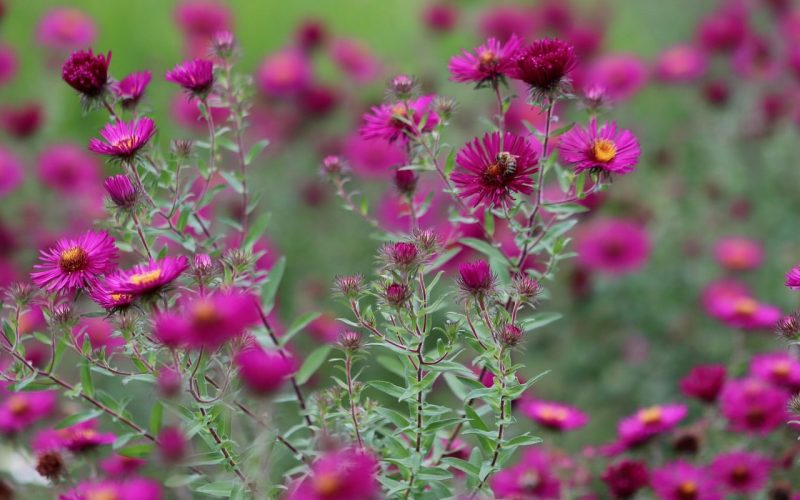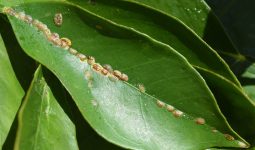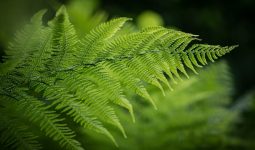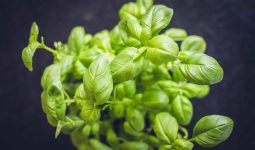A lovely landscape in your shady yard is possible with the right low-maintenance perennials for shade.
These shade-loving perennials have delicate, exotic flowers and lovely leaf colors.
Add a handful of these shady plants to your yard and relax. They’ll improve your yard’s aesthetics while allowing you to spend less time maintaining it.
1. Plantain Lilies
Plantain lilies are your finest option to add attractive foliage to your shaded areas. Any yard area can benefit from the brightness and refined texture that these wonderful, low-maintenance plants can add.
There are numerous varieties with various leaf shapes, variegation patterns, and shades of green. Furthermore, plantain lilies prefer substrates that are fertile and well-draining.
The colors of their leaves typically indicate whether they prefer light or shade. Golden-hued types tend to like some early sun.
These plants can flourish outside of pots or containers, so different types can be positioned next to one another to show their small differences.
These can provide enticing lushness to a shaded landscape under the proper conditions.
2. Purple Coneflower
Purple coneflower is also one of the low-maintenance perennials for shade. It favors grasslands, wooded areas, and arid landscapes, making it ideal for any wildflower garden.
It tends to thrive in full-sun regions but can survive in moderate shade. After its roots are completely developed, it can withstand various environmental conditions.
This species is ideal for attracting pollinators to damp meadows and shaded gardens. Furthermore, it is around 47 inches (119 cm) tall.
Its inflorescences have a dome-like structure and can reach a full diameter of six inches (15 cm). Blooms can develop at any time between April and September.
This species has various cultivars, some of which have also earned the RHS Award of Garden Merit. It is important to note that they are likely to reseed in loamy, well-drained soil.
3. Coral Bells
Coral bells are among low-maintenance perennials for shade and produce lovely foliage. Its cultivars come in a wide range of colors.
While some have brilliantly colorful leaves, others stand out more because of their dark veins and melancholy tones.
Most coral bell species prefer partial to full shade, as their leaves are prone to burning and moisture loss. Shade also makes their colors more vibrant.
Even though the foliage is enough to stand out independently, the summer blooms undoubtedly help capture attention. These could be the same color as the leaves or completely different from the rest of the plant.
4. Spotted Dead Nettles
Any garden, whether it is fully or partially shaded, will benefit from the addition of this flowering perennial. It’s also among the low-maintenance perennials for shade.
Because of its thin stems, which reach only 4 to 8 inches in height, it can be used as a groundcover or miniature edge plant.
Also, it prefers cool temperatures and wilts under direct sunlight; thus, low light and shade are ideal for its cultivation. Therefore, it can also be planted in the shade of bigger shrubs and perennials.
Spotted dead-nettles bloom from April to November. The upper petals, formed like a helmet and hanging above the tube, give the blooms a beautifully hooded appearance.
These can be found in leafy verticillasters, a multi-leveled inflorescence with blooms that resemble whorls.
This floral arrangement is widespread in the Lamiaceae family, which includes this species. It gets its common name from the hairy leaves that mimic stinging nettles.
5. Oak Leaf Hydrangea
Oak leaf hydrangeas are woody, deciduous shrubs that prefer partial shade and have leaves resembling an oak tree.
These low-maintenance perennials for shade require little pruning and have beautiful leaves and blossoms! Oak leaf hydrangeas are an excellent addition to any shady garden.
Because they establish quickly and have bushy growth that can reach up to 20 feet in height, they do well in partial shade and can help fill huge spaces.
The large, cone-shaped clusters of dark green leaves emerge in the early spring and are covered with tiny white flowers by the summer.
There is an Oak Leaf Hydrangea for every landscape need, from tiny, miniature cultivars to large types.
6. Bleeding Heart
The magnificent blossoms of the bleeding heart plant show early in the spring. They are among the earliest plants to bloom in the shade garden.
Few shade flowers can compare to the allure of the typical bleeding heart, which has heart-shaped blossoms arching up from fern-like foliage.
This plant withers away in the summer after blooming. Hostas or plants with bold leaves that will grow up and cover the withering foliage should be planted to hide it.
Bleeding hearts thrive in woodland settings with other shade-loving plants.
7. Columbines
This is also among low-maintenance perennials for shade. Columbine flowers are a welcome sign of spring and adorn any shade garden.
They normally have a two- to three-week blooming window in the spring and flower quite early. Cool-season perennial columbines dislike hot summers.
Columbines are perennial plants with a short lifespan but heavily self-seed in the garden. They are distinguished by their distinctive blossoms, which resemble a jester’s hat.
Once planted, they can withstand drought and grow in moderate shade. Columbines are usually put alongside other perennials that can tolerate shade near the edge of rock gardens.
8. Boxwood
The evergreen boxwood is the little black dress of the botanical world since it complements everything, thrives in sun or partial shade, and isn’t picky about soil.
There are cultivars for every garden, whether you need a huge shrub for screening or something smaller to complement perennials or define an edge.
In addition, some boxwoods are naturally rounded, conical, or erect, which increases their flexibility.
Of course, you can completely disregard them and leave them unsheared, but pull out the clippers if you want a more formal appearance.
9. Clematis
This is also among the low-maintenance perennials for shade. Even in a small garden, there is room to tuck a clematis vine; it will coil enchantment around whatever is in its path.
Clematis blue, purple, pink, white, and yellow flowers look especially lovely when allowed to cling to shrubs or small trees.
Although clematis can tolerate some shade and part of the sun, they flower best when they receive at least a few hours of direct sunlight daily. If you plant clematis deeply and cover them carefully, their roots will stay cool.
10. Asparagus Fern
The asparagus fern, a common houseplant, is accustomed to the climate of heavily shaded places. It is also among the low-maintenance perennials for shade on this list.
Its evergreen foliage enhances low-light gardens or areas with dappled shade, a unique texture, and vibrant color.
It is usually cultivated in elegant pots under trees, on a veranda or patio, or in hanging baskets.
Despite its common name, it is not a fern species. It is a blooming plant more closely linked to the vegetable asparagus.
The distinctive feature of the asparagus fern is its photosynthetic cladodes, specialized stem structures frequently confused with the plant’s leaves.
It is advised to use gloves when handling the plant because they can be fairly sharp to the touch. In addition, the stems should be kept out of the direct sun because they are susceptible to scorching.
In the right locations, they may produce inconspicuous white blooms that eventually turn into tiny, mildly poisonous berries.
11. Big Leaf Periwinkle
This evergreen plant is happy to expand its roots and shoots in heavily shaded locations. The full sun produces more blossoms; however, the full shade makes the plant bushier.
Its populations are mostly restricted to areas with constantly damp vegetation along the borders of freshwater bodies in the wild.
As a result, it can be raised as a lovely groundcover plant for the shady areas of rain gardens and pond borders.
Because it is a trailing plant, it usually spreads on its own, establishing roots at the stem nodes that come into touch with the ground.
This perennial herb has delicate stems with deep green leaves arranged in opposition. While flowering stems remain erect, non-flowering stems frequently extend outward.
If you want your stem cuttings to cover a large area, place them 12 to 18 inches (30 to 46 cm) apart. To control their spread, Grow them outside of pots or containers.








